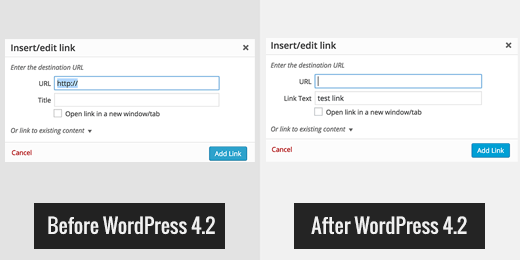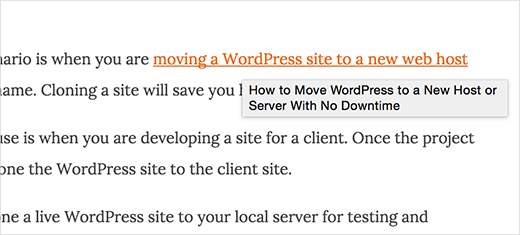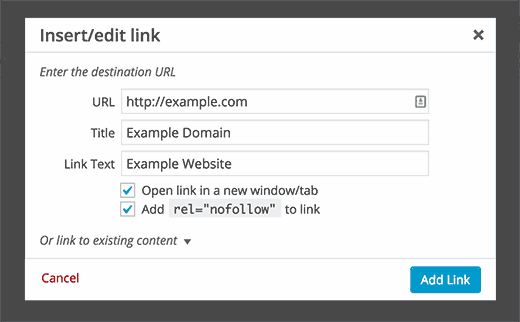In WordPress 4.2 wurde das Feld für den Link-Titel im Abschnitt “Link einfügen” durch das Feld für den Link-Text ersetzt. Dies war für viele Benutzer, die glauben, dass das Link-Titel-Feld für SEO-Zwecke nützlich ist, ein wenig enttäuschend. In diesem Artikel zeigen wir Ihnen, wie Sie das fehlende Link-Titel-Feld in WordPress 4.2 und späteren Versionen hinzufügen können.

Warum wurde das Link-Titel-Feld entfernt?
Der Link-Titel liefert einen Titel für den Link, der sich vom Ankertext eines Links unterscheiden kann. Er bietet den Benutzern die Möglichkeit, den Titel des verlinkten Dokuments zu sehen. Einige Benutzer glaubten, dass dies Vorteile für die Zugänglichkeit hat, aber tatsächlich können viele Bildschirmlesegeräte das Titelattribut in Links nicht lesen. Das Link-Titel-Popup kann von Benutzern auf mobilen und anderen Handheld-Geräten nicht gesehen werden. Diese Popups sind auch für Benutzer, die nur die Tastatur benutzen, nicht sichtbar.

Viele Nutzer glauben, dass der Link-Titeltext auch für die Suchmaschinenoptimierung von Bedeutung ist. Er ermöglicht es Website-Besitzern, tatsächliche Dokumententitel im Titel und ihre Schlüsselwörter als Ankertext zu verwenden. Vielleicht möchten Sie auch unseren Artikel über Bild-Alt-Text vs. Bildtitel lesen.
Unabhängig davon, ob es SEO- oder Zugänglichkeitsvorteile gibt, ist das Link-Titel-Attribut sicherlich unbedenklich. Hier erfahren Sie, wie Sie es wieder in Ihre WordPress-Website einbauen können.
Link-Titel-Feld wieder in WordPress einfügen
Als erstes müssen Sie das Title and Nofollow For Links Plugin installieren und aktivieren. Es ist sofort einsatzbereit und es gibt keine Einstellungen, die Sie konfigurieren müssen.
Erstellen Sie einfach einen neuen Beitrag oder bearbeiten Sie einen bestehenden Beitrag. Wählen Sie einen Text aus und klicken Sie auf die Schaltfläche Link einfügen im Editor. Es erscheint ein Popup-Fenster zum Einfügen von Links und Sie werden feststellen, dass dort ein zusätzliches Feld für den Link-Titel angezeigt wird.

Dieses Plugin fügt auch ein rel=”nofollow”-Kontrollkästchen hinzu, wenn Sie es verwenden möchten. Lesen Sie mehr darüber, warum und wann Sie nofollow-Links verwenden sollten.
Wir hoffen, dass dieser Artikel Ihnen geholfen hat, das fehlende Link-Titelfeld in WordPress 4.2 und späteren Versionen hinzuzufügen. Vielleicht interessiert Sie auch unsere Anleitung, wie Sie defekte Links in WordPress reparieren können.
Wenn Ihnen dieser Artikel gefallen hat, dann abonnieren Sie bitte unseren YouTube-Kanal für WordPress-Videotutorials. Sie können uns auch auf Twitter und Facebook finden.





Kay
This plug-in works like a charm. Thank you. I found you from a Google search after discovering the title tag was no longer available.
Christian Schnettelker
Thanks for the hint, the plugin works very well. Has been driving me nuts to add the link title manually in text view.
Cathy Miller
Yay! Thank you. This has been driving me nuts to add this manually.
Rufus B
Looks like “Kids” that have Not learned that “IF IT AIN’T BROKE, DO NOT FIX IT” are running the show here.
Trying to justify their job by irritating their clients, customers, and users.
Chris
Code manual u newbs
Mark Robinson
Or you could just edit the “alt” tag in html view and avoid clogging they system with another plugin.
Otto
You mean the “title” tag, and the plugin does nothing other than make that easier. I wrote it. I know.
Michael Maxson
A little disappointed…what an understatement! Check out the comments on the following link
https://wordpress.org/support/topic/insertedit-link-missing-title-field?replies=51
By the way, the Ottopress plugin has been working fine for me for days.
Also check out comment on WP trac at https://core.trac.wordpress.org/ticket/32095
“It’s Not A Feature…It’s A Bug. LOL
Otto
The title attribute is useless for SEO, but, I believe in choice. If somebody really wants it, then the plugin offers that choice n it’s a very simple, low-impact plugin
Serena Scholl
Thank you, Otto!! You and other WordPress peeps are AWESOME!!!The amazingness of FREE and incredible blogging / web software is … There are no words. Thank you! Thank you! Thank you!
Christian Nelson
The articles I’ve seen on this topic (including this article) give the impression that most people who liked the pre-4.2 behavior liked it for SEO and accessibility reasons.
That might be true, but I doubt that I’m the only one who liked that behavior because it let me give my readers more of a clue about what they were going to see when they clicked the link…sort of an additional confirmation of where they were heading.
What’s most irritating about this is the arrogant attitude of the WordPress developers when responding to complaints about this less-than-helpful change. Paraphrasing: “We know what’s best of you, and if you don’t like it, you know where to go.”
They’re heading for a fall.
Viktoria Michaelis
For me the link title is not quite so important, but the link itself is. So, since v4.2 I have been adding the link in by hand, through the text version, since the link command doesn’t seem to want to do what it is supposed to. But, perhaps there is a plug-in for that too….